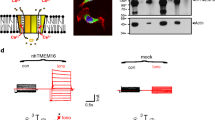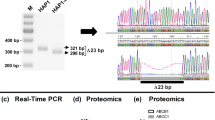Abstract
Besides the well-known sarco/endoplasmic-reticulum Ca2+-transport ATPases (SERCA), animal cells contain a much less characterized P-type Ca2+-transport ATPase: the PMR1/SPCA Ca2+/Mn2+-transport ATPase. SPCA is mainly targeted to the Golgi apparatus. Phylogenetic analysis indicates that it might be more closely related to a putative ancestral Ca2+ pump than SERCA. SPCA supplies the Golgi apparatus, and possibly other more distal compartments of the secretory pathway, with the Ca2+ and Mn2+ necessary for the production and processing of secretory proteins. In the lactating mammary gland, SPCA appears to be the primary pump responsible for supplementing the milk with high (60–100 mM) Ca2+. It could also play a role in detoxification of cells overloaded with Mn2+. Mutations in the human gene encoding the SPCA pump (ATP2C1) result in Hailey–Hailey disease, a keratinocyte disorder characterized by incomplete cell adhesion. Recent observations show that the Golgi apparatus can function as a Ca2+ store, which can be involved in setting up cytosolic Ca2+ oscillations.

Similar content being viewed by others
References
Antebi A, Fink GR (1992) The yeast Ca2+-ATPase homologue, PMR1, is required for normal Golgi function and localizes in a novel Golgi-like distribution. Mol Biol Cell 3:633–654
Axelsen KB, Palmgren MG (1998) Evolution of substrate specificities in the P-type ATPase superfamily. J Mol Evol 46:84–101
Axelsen KB, Palmgren MG (2001) Inventory of the superfamily of P-type ion pumps in Arabidopsis. Plant Physiol 126:696–706
Berridge MJ (1990) Calcium oscillations. J Biol Chem 265:9583–9586
Berridge MJ, Galione A (1988) Cytosolic calcium oscillators. FASEB J 2:3074–3082
Bezprozvanny I, Watras J, Ehrlich BE (1991) Bell-shaped calcium-response curves of Ins(1,4,5)P3- and calcium-gated channels from endoplasmic reticulum of cerebellum. Nature 351:751–754
Bolton EC, Mildvan AS, Boeke JD (2002) Inhibition of reverse transcription in vivo by elevated manganese ion concentration. Mol Cell 9:879–889
Catty P, de Kerchove d'Exaerde A, Goffeau A (1997) The complete inventory of the yeast Saccharomyces cerevisiae P-type transport ATPases. FEBS Lett 409:325–332
Chanat E, Huttner WB (1991) Milieu-induced, selective aggregation of regulated secretory proteins in the trans-Golgi network. J Cell Biol 115:1505–1519
Chandra S, Kable EP, Morrison GH, Webb WW (1991) Calcium sequestration in the Golgi apparatus of cultured mammalian cells revealed by laser scanning confocal microscopy and ion microscopy. J Cell Sci 100:747–752
Chiesi M, Inesi G (1980) Adenosine 5′-triphosphate dependent fluxes of manganese and hydrogen ions in sarcoplasmic reticulum vesicles. Biochemistry 19:2912–2918
Cronin SR, Rao RJ, Hampton RY (2002) Cod1p/Spf1p is a P-type ATPase involved in ER function and Ca2+ homeostasis. J Cell Biol 157:1017–1028
Davidson HW, Rhodes CJ, Hutton JC (1988) Intraorganellar calcium and pH control proinsulin cleavage in the pancreatic beta cell via two distinct site-specific endopeptidases. Nature 333:93–96
Dürr G, Strayle J, Plemper R, Elbs S, Klee SK, Catty P, Wolf DH, Rudolph HK (1998) The medial-Golgi ion pump Pmr1 supplies the yeast secretory pathway with Ca2+ and Mn2+ required for glycosylation, sorting, and endoplasmic reticulum-associated protein degradation. Mol Biol Cell 9:1149–1162
Finch EA, Turner TJ, Goldin SM (1991) Calcium as a coagonist of inositol 1,4,5-trisphosphate-induced calcium release. Science 252:443–446
Gomes da Costa A, Madeira VM (1986) Magnesium and manganese ions modulate Ca2+ uptake and its energetic coupling in sarcoplasmic reticulum. Arch Biochem Biophys 249:199–206
Gunteski-Hamblin A, Clarke DM, Shull GE (1992) Molecular cloning and tissue distribution of alternatively spliced mRNAs encoding possible mammalian homologues of the yeast secretory pathway calcium pump. Biochemistry 31:7600–7608
Halachmi D, Eilam Y (1996) Elevated cytosolic free Ca2+ concentrations and massive Ca2+ accumulation within vacuoles, in yeast mutant lacking PMR1, a homolog of Ca2+ -ATPase. FEBS Lett 392:194–200
Hirata Y (2002) Manganese-induced apoptosis in PC12 cells. Neurotoxicol Teratol 24:639–653
Honoré B, Vorum H (2000) The CREC family, a novel family of multiple EF-hand, low-affinity Ca2+-binding proteins localised to the secretory pathway of mammalian cells. FEBS Lett 466:11–18
Hu Z, Bonifas JM, Beech J, Bench G, Shigihara T, Ogawa H, Ikeda S, Mauro T, Epstein EH Jr (2000) Mutations in ATP2C1, encoding a calcium pump, cause Hailey-Hailey disease. Nat Genet 24:61–65
Iino M (1990) Biphasic Ca2+ dependence of inositol 1,4,5-trisphosphate-induced Ca release in smooth muscle cells of the guinea pig taenia caeci. J Gen Physiol 95:1103–1122
Ivessa NE, De Lemos-Chiarandini C, Gravotta D, Sabatini DD, Kreibich G (1995) The Brefeldin A-induced retrograde transport from the Golgi apparatus to the endoplasmic reticulum depends on calcium sequestered to intracellular stores. J Biol Chem 270:25960–25967
Kowarski D, Shuman H, Somlyo AP, Somlyo AV (1985) Calcium release by noradrenaline from central sarcoplasmic reticulum in rabbit main pulmonary artery smooth muscle. J Physiol (Lond) 366:153–175
LaFerla FM (2002) Calcium dyshomeostasis and intracellular signalling in Alzheimer's disease. Nat Rev Neurosci 3:862–872
Lapinskas PJ, Cunningham KW, Liu XF, Fink GR, Culotta VC (1995) Mutations in PMR1 suppress oxidative damage in yeast cells lacking superoxide dismutase. Mol Cell Biol 15:1382–1388
Lin P, Yao Y, Hofmeister R, Tsien RY, Farquhar MG (1999) Overexpression of CALNUC (nucleobindin) increases agonist and thapsigargin releasable Ca2+ storage in the Golgi. J Cell Biol 145:279–289
Luk EE, Culotta VC (2001) Manganese superoxide dismutase in Saccharomyces cerevisiae acquires its metal co-factor through a pathway involving the Nramp metal transporter, Smf2p. J Biol Chem 276:47556–47562
Mandal D, Woolf TB, Rao R (2000) Manganese selectivity of pmr1, the yeast secretory pathway ion pump, is defined by residue Gln783 in transmembrane segment 6. Residue Asp778 is essential for cation transport. J Biol Chem 275:23933–23938
Marchi V, Sorin A, Wei Y, Rao R (1999) Induction of vacuolar Ca2+-ATPase and H+/Ca2+ exchange activity in yeast mutants lacking Pmr1, the Golgi Ca2+-ATPase. FEBS Lett 454:181–186
Michalak M, Corbett EF, Mesaeli N, Nakamura K, Opas M (1999) Calreticulin: one protein, one gene, many functions. Biochem J 344:281–292
Missiaen L, De Smedt H, Droogmans G, Casteels R (1992) Ca2+ release induced by inositol 1,4,5-trisphosphate is a steady-state phenomenon controlled by luminal Ca2+ in permeabilized cells. Nature 357:599–602
Missiaen L, Taylor CW, Berridge MJ (1992) Luminal Ca2+ promoting spontaneous Ca2+ release from inositol trisphosphate-sensitive stores in rat hepatocytes. J Physiol (Lond) 455:623–640
Missiaen L, Van Acker K, Parys JB, De Smedt H, Van Baelen K, Weidema AF, Vanoevelen J, Raeymaekers L, Renders J, Callewaert G, Rizzuto R, Wuytack F (2001) Baseline cytosolic Ca2+ oscillations derived from a non-endoplasmic reticulum Ca2+ store. J Biol Chem 276:39161–39170
Missiaen L, Vanoevelen J, Van Acker K, Raeymaekers L, Parys JB, Callewaert G, Wuytack F, De Smedt H (2002) Ca2+ signals in Pmr1-GFP expressing COS-1 cells with functional endoplasmic reticulum. Biochem Biophys Res Commun 294:249–253
Missiaen L, Vanoevelen J, Parys JB, Raeymaekers L, De Smedt H, Callewaert G, Erneux C, Wuytack F (2002) Ca2+ uptake and release properties of a thapsigargin-insensitive nonmitochondrial Ca2+ store in A7r5 and 16HBE14o- cells. J Biol Chem 277:6898–6902
Mitchel KJ, Pinton P, Varadi A, Tacchetti C, Ainscow EK, Pozzan T, Rizzuto R, Rutter GA (2001) Dense core secretory vesicles revealed as a dynamic Ca2+ store in neuroendocrine cells with a vesicle-associated membrane protein aequorin chimaera. J Cell Biol 155:41–51
Morel-Huaux VM, Pypaert M, Wouters S, Tartakoff AM, Jurgan U, Gevaert K, Courtoy PJ (2002) The calcium-binding protein p54/NEFA is a novel luminal resident of medial Golgi cisternae that traffics independently of mannosidase II. Eur J Cell Biol 81:87–100
Pezzati R, Bossi M, Podini P, Meldolesi J, Grohovaz F (1997) High-resolution calcium mapping of the endoplasmic reticulum-Golgi-exocytic membrane system. Electron energy loss imaging analysis of quick frozen-freeze dried PC12 cells. Mol Biol Cell 8:1501–1512
Pinton P, Pozzan T, Rizzuto R (1998) The Golgi apparatus is an inositol 1,4,5-trisphosphate-sensitive Ca2+ store, with functional properties distinct from those of the endoplasmic reticulum. EMBO J 17:5298–5308
Powell JT, Brew K (1976) Metal ion activation of galactosyltransferase. J Biol Chem 251:3645–3652
Putney JW Jr (1986) A model for receptor-regulated calcium entry. Cell Calcium 7:1–12
Raeymaekers L, Wuytack EY, Willems I, Michiels CW, Wuytack F (2002) Expression of a P-type Ca2+-transport ATPase in Bacillus subtilis during sporulation. Cell Calcium 32:93–103
Reinhardt TA, Filoteo AG, Penniston JT, Horst RL (2000) Ca2+-ATPase protein expression in mammary tissue. Am J Physiol 279:C1595–C1602
Rizzuto R, Brini M, Murgia M, Pozzan T (1993) Microdomains with high Ca2+ close to IP3-sensitive channels that are sensed by neighboring mitochondria. Science 262:744–747
Rudolph HK, Antebi A, Fink GR, Buckley CM, Dorman TE, LeVitre J, Davidow LS, Mao JI, Moir DT (1989) The yeast secretory pathway is perturbed by mutations in PMR1, a member of a Ca2+ ATPase family. Cell 58:133–145
Schmidt WK, Moore HP (1995) Ionic milieu controls the compartment-specific activation of pro-opiomelanocortin processing in AtT-20 cells. Mol Biol Cell 6:1271–1285
Sorin A, Rosas G, Rao R (1997) PMR1, a Ca2+-ATPase in yeast Golgi, has properties distinct from sarco/endoplasmic reticulum and plasma membrane calcium pumps. J Biol Chem 272:9895–9901
Steiner DF (1998) The proprotein convertases. Curr Opin Chem Biol 2:31–39
Strayle J, Pozzan T, Rudolph HK (1999) Steady-state free Ca2+ in the yeast endoplasmic reticulum reaches only 10 μM and is mainly controlled by the secretory pathway pump pmr1. EMBO J 18:4733–4743
Sudbrak R, Brown J, Dobson-Stone C, Carter S, Ramser J, White J, Healy E, Dissanayake M, Larregue M, Perrussel M, Lehrach H, Munro CS, Strachan T, Burge S, Hovnanian A, Monaco AP (2000) Hailey-Hailey disease is caused by mutations in ATP2C1 encoding a novel Ca2+ pump. Hum Mol Genet 9:1131–1140
Ton VK, Mandal D, Vahadji C, Rao R (2002) Functional expression in yeast of the human secretory pathway Ca2+,Mn2+-ATPase defective in Hailey-Hailey disease. J Biol Chem 277:6422–6427
Towler MC, Prescott AR, James J, Lucocq JM, Ponnambalam S (2000) The manganese cation disrupts membrane dynamics along the secretory pathway. Exp Cell Res 259:167–179
Van Baelen K, Vanoevelen J, Missiaen L, Raeymaekers L, Wuytack F (2001) The Golgi PMR1 P-type ATPase of Caenorhabditis elegans. Identification of the gene and demonstration of calcium and manganese transport. J Biol Chem 276:10683–10691
Wei Y, Chen J, Rosas G, Tompkins DA, Holt PA, Rao R (2000) Phenotypic screening of mutations in Pmr1, the yeast secretory pathway Ca2+/Mn2+-ATPase, reveals residues critical for ion selectivity and transport. J Biol Chem 275:23927–23932
Author information
Authors and Affiliations
Corresponding author
Rights and permissions
About this article
Cite this article
Wuytack, F., Raeymaekers, L. & Missiaen, L. PMR1/SPCA Ca2+ pumps and the role of the Golgi apparatus as a Ca2+ store. Pflugers Arch - Eur J Physiol 446, 148–153 (2003). https://doi.org/10.1007/s00424-003-1011-5
Accepted:
Published:
Issue Date:
DOI: https://doi.org/10.1007/s00424-003-1011-5




